by TRA
Lens Data Summary
Ukrainian shift & shift/tilt lenses with Pentacon Six mount
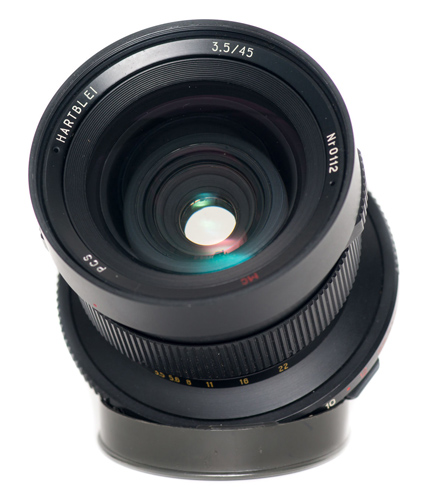
[h45shft1.jpg]
|
by TRA Lens Data Summary Ukrainian shift & shift/tilt lenses with Pentacon Six mount  The Hartblei 45mm f/3.5 shift
lens
[h45shft1.jpg] |
|
In recent years two Ukrainian manufacturers, Arsat and Hartblei, have introduced shift and shift/tilt lens in the Pentacon Six mount. There are also some shift and shift/tilt lenses from “Wiese”, a German firm based in Hamburg. However, it appears that all of the Wiese lenses are re-branded Hartblei lenses. Shift
lenses from Arsat and Hartblei
Notes It is reported that the 45mm and 65mm Hartblei shift lenses use the optical elements of the Arsenal Mir-26B and Mir-38B, respectively. Hartblei adds an excellent multi-coating that looks far superior to that on the original Arsenal lenses. To see a test of the 45mm Hartblei shift-only lens, click here. Arsenal in Kiev produce their own “Arsat” 55mm shift lens, which is one of the sharpest lenses available in the Pentacon Six mount. The
Arsenal (“ARSAT”) Shift lenses Arsenal are now also producing 45mm &
65mm shift lenses, bearing their ARSAT brand name.
I do not know if the 65mm lens is optically the same as
the Hartblei shift lenses, but this is very probable. I
now have the 45mm Arsat shift lens, and, without
disassembling it, it appears that the optical elements
are identical to those in the 45mm Hartblei shift
lens. A report on the Arsat 45mm shift lens can be
seen here. All five lenses (the 45mm lenses from Hartblei and from Arsat, the 65mm lenses from Hartblei and Arsat, and the 55mm lens from Arsat only) are in mounts that rotate – so it is possible to shift down as well as up, sideways, or even in other diagonal directions if required. In all the shift (and shift/tilt) lenses that I have personally handled so far, rotation is the full 360°, with click stops every 15°. All the shift and shift/tilt lenses have a manual preset diaphragm. The Hartblei PCS 45mm f/3.5 shift-only lens has détentes at half and full stops throughout its entire range all the way down to f/22. Other shift and shift/tilt lenses that I have handled have détentes at half stops and full stops down to f/11, and then only at full stops to f/22. The 55mm shift lens has a socket for a cable release. Using a double cable release, it is possible to automate the aperture shut-down on this lens. For more information on shift lenses,
click here. To see a report on two shift lenses
and one shift-tilt lens from Wiese Fototechnik in
Hamburg, click here. The Hartblei Shift/Tilt lenses As well as their shift-only lenses,
listed above, Hartblei advertised the following shift
& tilt lenses:
Notes |
||||||||||||||||||||||||||||||||||||||||||||||||||||||||||||||||||||||||||||||||||||||||||||||
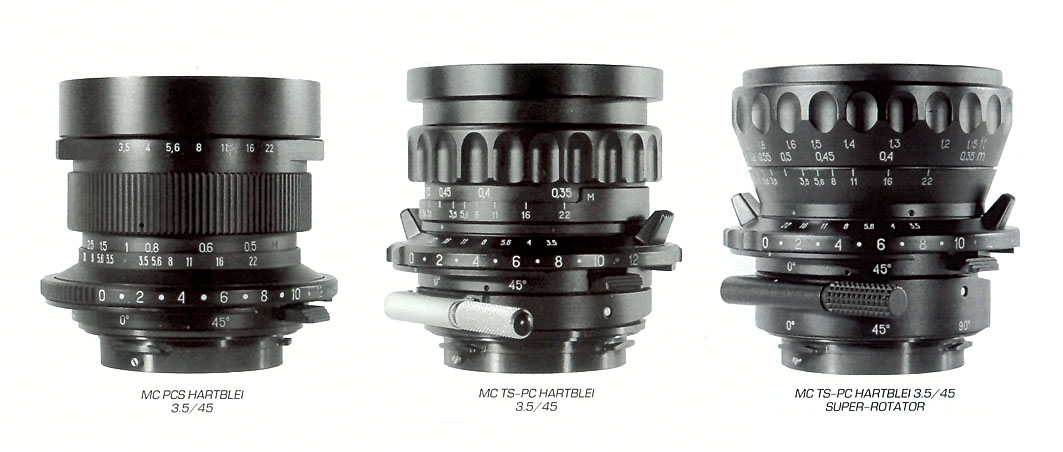 The three 45mm shift and shift/tilt lenses from Hartblei From L to R: shift only, shift (in any direction) & tilt down, shift & tilt in any direction (“Super-Rotator”) (Illustration from a Hartblei lens manual) |
| The above
three lenses “in the flesh”: |
||||
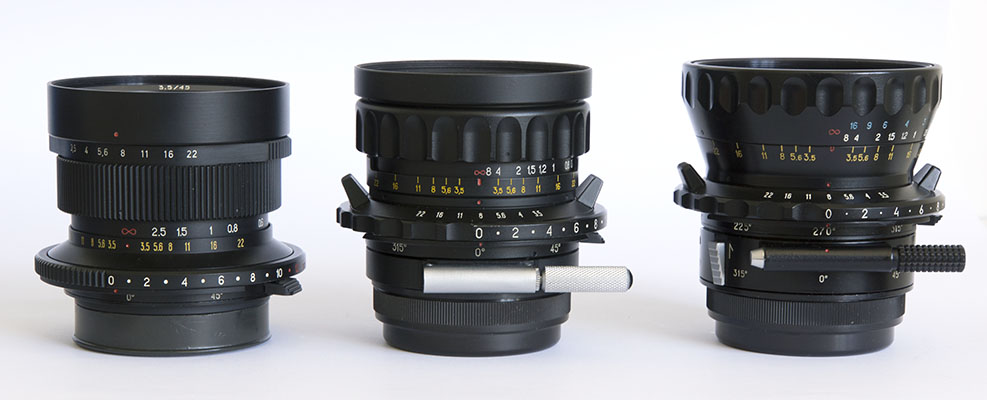 At infinity focus.
The “wings” on the Tilt/Shift lens (middle) and the
Super-Rotator (right) operate the aperture ring.
[3x45T02.jpg]
|
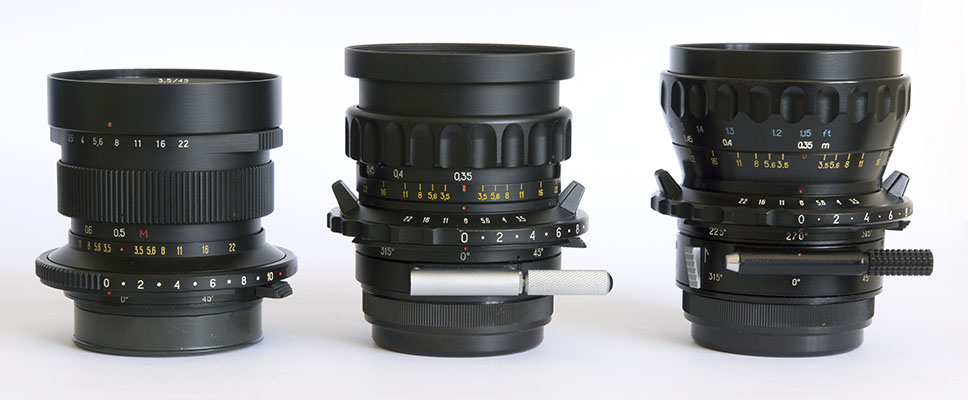 The same three lenses at closest
focus. We observe that for the shift-only lens
(on the left) the closest focus is 0.5m (approximately
18 inches), whereas for the other two lenses it is
closer, at 0.35m (approximately one foot, which is
extremely close).
[3x45T03.jpg]
|
|||
|
To the right, the middle of the three
lenses in the above two pictures, the Wiese “Technoplan
- T” version of the tilt/shift lens, has been focussed
at 0.45m, with zero tilt and zero shift. Click on
the image to see it larger. We could have got
substantially closer, if we had wished, making this very
nearly a “macro” lens. Even without tilting the
lens, depth of field is substantial, helped by two
factors:
This was a
hand-held “grab shot” in the street, in
Bridgnorth, Shropshire, England. The image
could be improved by cropping it, but here we show
the whole frame. Shift-only lenses are generally used
for architectural and landscape photography, for which
the minimum focus of 0.5 metres is more than
adequate. Tilt lenses are often used for product
photography, where the closer minimum focus of 0.35
metres will be appreciated.
|
|
[C569_16s.jpg]
|
|||
| The Super-Rotator has two rotate mechanisms: one to rotate the shift in any direction and the other to rotate the tilt in any direction. The two mechanisms are completely independent of each other, thus providing the maximum flexibility that would be possible for this lens. | |||||
There is reported to be another source for shift
and tilt lenses in the Pentacon Six mount – the Austrian firm of
Atzmueller &
Rendl Linz. For details, return to the beginning of the
lens data section and choose “Other lenses in the Pentacon Six
mount”.
|
Hartblei 45mm Shift & Shift /
Tilt lenses
As can be seen from the above, Hartblei offer (or have in the past offered) three different 45mm shift and shift/tilt lenses. All of these lenses use the
optical elements of the Arsenal
45mm f/3.5 Mir-26 wide-angle lens, more details of which
can be seen here.
We look at each of these three lenses below.
However, the Mir-26 elements are mounted in three
different lens barrels, all of which are designed and
manufactured by Hartblei. The potential optical
quality of lenses manufactured in the former Soviet
Union has a justifiably high reputation.
Unfortunately, the actual manufacture and assembly of
the lens barrels was often shoddy, and there appeared
to be zero quality control, so that lenses were sold
that should have never got out the factory gate, since
at the quality control stage, they should have been
scrapped and thrown in the bin. By contrast, the quality of
the design and manufacture of the barrels of
Hartblei lenses is superb, and it
would appear that they also applied superior
multi-coating to the Arsenal lens elements that
they used.
All of these lenses (and all other Hartblei lenses that I have used) have super smooth focussing, a world away from the occasional gritty focussing sometimes encountered with lenses manufactured during the Soviet era in the USSR. Hartblei appears to use abbreviations with the following meanings: MC = Multi-Coated; PC = Perspective Control TS = Tilt-Shift. “PCS” would appear to mean Perspective Control - Shift. MC PCS Hartblei 3.5/45mm Shift lens This is a shift-only lens, with no tilt possibilities. I am familiar with two versions of this lens: the one bearing the Hartblei name, illustrated in the black-and-white picture above from a Hartblei lens instruction manual and also at the top of this page, and a lens that is also from Hartblei and has similar characteristics but that bears the Wiese name. The Wiese version is described in more detail here. Here we shall compare the Hartblei and Wiese versions. 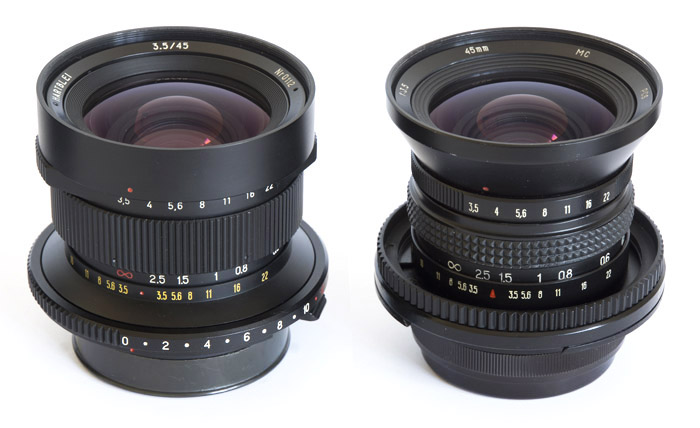 The Hartblei 45mm shift-only lens (left), beside the equivalent Wiese lens. Even though the Wiese lens almost certainly originated with Hartblei, the lens that here bears Hartblei's name is a significant improvement. It’s as though the “Wiese” lens were a “Mark I” version and the “Hartblei” lens an improved, “Mk II”, version. [ht45_03.jpg]
MC TS-PC Hartblei 3.5/45mm Shift/Tilt lens This Hartblei lens
offers shift in any direction, thanks to a rotating
mount, plus tilt downwards only. Of course, with
a square format it is possible to turn the camera
through 90 or 180 degrees, although operating it
upside down is not easy and in this position use of a
tripod becomes impossible (which is where the
Super-Rotator comes in! – see below). The same
lens has been seen with a Wiese name ring.
MC TS-PC Hartblei 3.5/45mm Super-Rotator Shift/Tilt lens This is Hartblei's top 45mm tilt/shift
lens. It incorporates two rotating mechanisms, one
in front of the other, so that both shift and tilt can
be independently controlled in any direction. This
lens was also available under the "Wiese" brand name, as
can be seen here
(scroll down to near the bottom of the page).
You can see further information on
the Super-Rotator and results of tests of it here (for shift only)
and here (for tilt). |
||||||||||||||||||||||||||||||||||
Next section (Ivanichek Petzvar)
To go back to the beginning of the Lens Data section, click
below and then choose the range of lenses that you want to read
about.
Back to beginning of the Lens Data
section
© TRA August 2007. Latest revision: April 2022